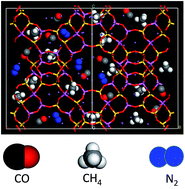Adsorption of carbon monoxide, methane and nitrogen on alkaline earth metal ion exchanged zeolite-X: structure, cation position and adsorption relationship†
Abstract
Development of zeolite based adsorbents with high adsorption capacity and selectivity is the key requirement for efficient and economic separation processes. However, less attention has been given so far towards understanding the mechanism of adsorption on the zeolites. In the present study adsorption of carbon monoxide, methane and nitrogen on zeolite-X exchanged with magnesium, calcium, strontium and barium cations was carried out using a volumetric gas adsorption method. Calcium, strontium, and barium ion exchanged zeolite-X shows increase in carbon monoxide, methane and nitrogen adsorption capacity. Strontium exchanged zeolite-X shows carbon monoxide adsorption capacity of 28.4 molecules per unit cell and calcium exchanged zeolite-X shows methane and nitrogen adsorption capacity of 18.8 and 13.8 molecules per unit cell, respectively at 303 K and 760 mm Hg pressure, maximum among the alkaline earth metal ion exchanged zeolite-X samples. However, barium exchanged zeolite-X shows methane/nitrogen selectivity of 1.78, maximum among the studied samples. The initial heat of adsorption for carbon monoxide, methane and nitrogen increases on calcium, strontium and barium ion exchange, and decreases with increase in the size of the cations due to decrease in the electrostatic interactions. However, magnesium exchanged zeolite-X shows decrease in the heat of adsorption. The significant decrease in adsorption capacity and heats of adsorption on magnesium ion exchange is due to the migration of small size magnesium ions inside the sodalite cages (I′ and II′) and D6R (site I) from the super cage (site II, III and III′) during activation, where cations are not accessible for adsorption. The change in adsorption capacity, selectivity and heats of adsorption for alkaline earth metal ion exchanged zeolite-X is discussed in terms of the size, location, and effective charges on the extra-framework cations present in the zeolite cavity and the subsequent electrostatic interactions between the adsorbed molecules and the extra-framework cations.


 Please wait while we load your content...
Please wait while we load your content...